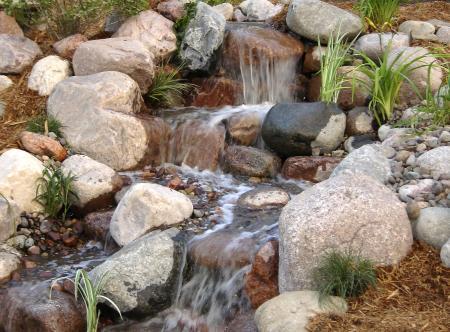 |
|
| A water garden can be made to fit your specific landscape needs. |
INSTALLATION
Liner:
A pond, two feet in depth, is ideal for zone 6. In zone 5 or less, dig a three-foot hole around a waterfall for increased winter protection for any fish you may wish to include in the pond. Make shelves to support edge rocks only, or for pre-determined edge planting. Sides should be steep (10 to 20 degree angle). Level the edges. Water seeks its own level. Clean excavation of stone and other projectiles. Line bottom with three inches of sand and 'damp pat' the hole in the sides. Lay a fabric liner cloth over the bottom and sides. Lay pre-cut P.V.C. or EPDM liner loosely into the hole. (Calculate liner size by measuring the maximum length and width, adding twice the maximum depth and at least two feet for edges). Fill with water and tuck the folds as the excavation fills. Edge with stones or plants and trim excess material.
- Tough and durable pond liners of P.V.C. are flexible membranes that make water gardens easy to install and non-rotting, frost-resistant and impermeable to roots.
- Their long life makes the pond permanent, yet it can be removed and reused, making it entirely portable.
- Flexible pond liners permit many shapes -- rectangular, square, round or free form. Three feet of depth in the centre permits overwintering of hardy water lilies. Ledges of different depths accommodate other water plants, including those that prefer shallow water.
- The liner is draped loosely over the excavation. Bricks or stones are placed on the overlap. As the pond is filled with water from a hose, the stones are eased off at intervals to allow the liner to fit snugly into the contours.
For in-ground ponds, dig a hole to fit the preformed pond, whether it is fibreglass or rigid plastic. Level the bottom and line with sand. Insert and fill with water. Back fill with sandy soil as it settles. Edge with your choice of materials.
For above ground, any rigid watertight container is ideal -- fibreglass, woodframe supported plastic, wine barrels, etc. Place on decks, balconies or difficult to dig soils. Remember, water weighs one kg per litre.
Pumps, waterfalls and fountains
Build rock waterfalls from the edge up. Use plastic liners to underlay and contain any excess run-off. Support rocks with rigid pieces of styrofoam.
Pumps are rated by gallons per hour or litres per minute. Choose one to fit the height and flow you need. A pump rated at 80 gph is minimum for a small water trickle or fountain. One rated at 1200 gph (with a one-inch discharge) is for larger flows at greater heights. Flow rate varies as height and number of connection splits. A Ground Fault Interrupter (GFI) power source must be within six to 12 inches of the pump.
PLANTING AND MAINTENANCE
Plants:
There are three types of water garden plants.
Underwater:
Oxygenators are very important for water quality. They compete successfully with algae for nutrients and are a major contributor to the "clearing" of the water.
Floating Plants:
Water lily pads, Floating Water Hyacinth, Floating Heart, etc. shade and cool the water, thereby contributing to algae control. Algae requires dissolved nutrients and sunlight to thrive, therefore about 60 per cent water coverage is ideal.
Marginal:
Edge planting and moisture-loving perennials not only create a pleasing appearance, they also utilize soluble nutrients and thus, help starve off algae. Tree shrubs and evergreens can be planted around or near the pond, but do not place them so that they shade the pond. The water surface should receive full sun all day.
Fish:
Add fish two weeks after plants have been established. Test water quality. Introduce inexpensive gold fish first. Under stock the pond until a 'balance' is found.
Do not feed or over-feed the fish as there is enough larvae, dead algae and vegetation to nurture them. Fish tend to over eat and contribute to an ammonia imbalance. Fish waste breaks down by beneficial bacteria into usable nutrients that the plants consume.
Algae:
Algae are best controlled by plants and fish in a well-balanced pond. Algaecides are a temporary control.
Winter:
Remove fallen leaves and decaying plant material. Leave fish and hardy plants in ponds that are two feet deep. Marginal hardy plants freeze in winter and revive in the spring. Tropical plants require tropical conditions indoors to survive. Cover ponds that are less than two feet deep and install an oxygen bubbler for the fish. Empty shallow ponds and above ground containers.
Spring:
Clean out major bottom debris. Bacteria will take care of the rest. Do not replace "old" water. It is already conditioned. When plants grow, the pond will balance itself, e.g. Water lilies. Spring feed fish when water is above 10°C.
Sit back and enjoy
If someone says that water gardens are difficult to build and hard to maintain, then sit back and watch them weed and fertilize their gardens.
CONSTRUCTION TIPS:
- Cut out the header pool and steps from well-compacted soil.
- Treat each pool or step as a separate unit with its own liner. The sides of the liner must be kept above the anticipated water level. Each step should start back from the lip, so that when water is turned off, some water remains at each level.
- Rockery stones can be added for a more natural effect.
- Additional features that can be added are a submersible pump with fountain head, and underwater lighting.
- In addition to the main water plants, add snails, goldfish and oxygenating plants to create an algae- and insect-free, self-sustaining life system.